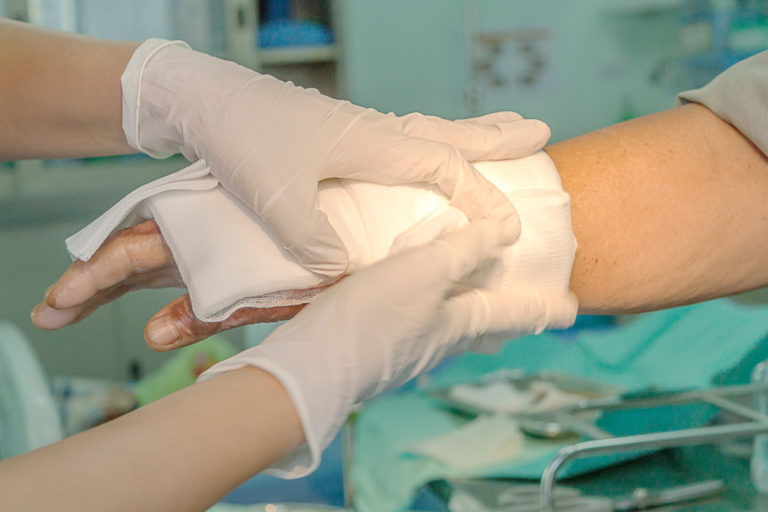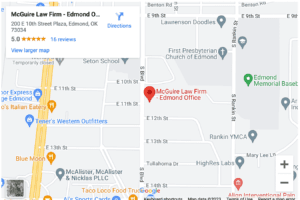Degloving Injury Attorney in Oklahoma City

One of the most severe injuries you can suffer is a degloving injury. A degloving injury happens when the skin and flesh are peeled off of your body, like a glove peeling off of your hand.
These injuries can leave you permanently scarred, disfigured, and disabled. You might lose a substantial piece of your flesh, and the remaining flesh could lose strength, flexibility, and sensation.
Here is some information about how a degloving injury happens and what kind of compensation you can seek for it.
What Is the Structure of Your Skin and Soft Tissue?

Your skeleton gives your body structure.
The rigid bones give your tendons an anchoring point and provide leverage for your muscles to move your body.
The Skin
Over your bones, you have several layers of tissue. Your skin covers your body. It protects your body from microorganisms, radiation, and chemicals. It also keeps moisture in. Without your skin, you risk infection and dehydration.
Your skin has three layers. The epidermis sits on the upper surface. It forms a barrier against the outside world. It also makes new skin to keep your protective layer intact.
The dermis sits below the epidermis. The dermis carries the nerve endings that give you your sense of touch. It also carries the blood vessels that feed your skin. The dermis produces oil to soften your skin and sweat to regulate body temperature.
The hypodermis sits at the lowest level. It includes a layer of fat and connects to the muscles under your skin. It also cushions your body and insulates it from extreme temperatures.
The Soft Tissue
Below the skin sits your muscles and tendons. The muscles move your body, and the tendons anchor the muscles to your skeleton. The muscle fibers are wrapped in a fascia that gives the muscles their shape.
Nerves and blood vessels run through and below your muscles. Nerves carry motor signals from your brain to your muscles. They also carry sensory signals back to your brain. These touch signals include perceptions of pressure, texture, and temperature.
Blood vessels feed all of the cells of your skin, soft tissue, and bones. Cell metabolism consumes oxygen and releases carbon dioxide. The blood carries oxygen and nutrients to feed your cells and carries away the waste.
What Is a Degloving Injury?
Degloving injuries, also called avulsion injuries, happen when the flesh gets stripped from your body. A partial degloving injury occurs when the flesh gets peeled off of your body but remains attached as a flap. In a complete degloving injury, the flesh gets separated from your body.
Degloving injuries often happen when the body scrapes across a surface. For example, in a motorcycle accident, pedestrian accident, bicycle accident, or even in motor vehicle accidents like car or truck crashes, your flesh might get degloved after you get hit by a car. Your body slides or gets dragged across the road surface, stripping the flesh from your body.
Bear in mind that degloving is not the same as abrading. In an abrasion injury, the flesh gets scraped off your body. In a degloving injury, the flesh gets sliced or torn from your body.
Degloving injuries can also happen in workplace accidents. A machine or tool might slice or tear your flesh from your body. This is one reason many workplaces will not allow you to wear jewelry or watches while working. If a factory machine grabs your ring or watch, it could strip the flesh right off of your hand.
What Is the Prognosis for a Degloving Injury?
Your outlook after a degloving injury depends on the depth of the injury. If you only lose the top layers of skin, doctors can repair the injury by replacing the degloved skin or performing a skin graft operation.
If you lose some of the soft tissue, doctors can suture the flap back into place so the muscle can heal. Assuming you only lost the nerve endings and small blood vessels, the soft tissue should reattach itself to your body. But you might have problems with the reattached tissue since nerve endings do not regrow.
If your degloving injury has damaged major nerves, doctors can attempt to reconnect the major nerves before reattaching the flesh to your body. Similarly, doctors can repair major severed blood vessels to provide circulation to the degloved flesh. But doctors might not have the ability or time to reconnect the smaller blood vessels and nerves, which could lead to complications.
What Complications Can Occur From a Degloving Injury?
Degloving injuries severely damage the tissue. By definition, the skin, muscle, and any blood vessels and nerves in the muscle get severed. This deprives the degloved tissue of blood circulation. As a result, the flesh could die before doctors can reattach it.
Even when doctors can reattach the degloved flesh, complications may arise, including:
Infection
Infection happens when bacteria enter your body. Between the toxic chemicals released by the bacteria and your body’s attempts to kill the bacteria, you can become very sick.
Symptoms of an infection include:
- Fever
- Chills
- Swelling
- Fluid or pus in the wound
Doctors can treat most infections with antibiotics. But if the infection spreads through your bloodstream, you risk septic shock and death.
Nerve Damage
If doctors cannot reattach all of the nerves, you might lose the nerve connections to the degloved tissue.
Even after doctors reattach the flesh, you might experience:
- Pain
- Weakness
- Numbness or tingling
- Loss of dexterity
- Loss of sensitivity to hot and cold
Unfortunately, nerve tissue does not reconnect itself. Once you lose sensation and control, you probably will not regain it.
Scarring
When skin regrows, the new skin cells do not have the elasticity of your original cells. This dense, tough skin forms scars. Degloving injuries can leave disfiguring scars, particularly when doctors use a skin graft to repair the wound.
What Compensation Is Available for a Degloving Injury?
After a degloving injury that resulted from someone else’s negligence, you may be entitled to compensation. If your degloving injury happened at work, Oklahoma law often limits you to workers’ compensation benefits. Workers’ compensation will cover your essential medical expenses and a portion of your lost income.
If you did not suffer your degloving injury at work, you could pursue compensation through an insurance claim or lawsuit against the at-fault party. This compensation may cover your medical expenses, lost income, and pain and suffering.
Contact an Oklahoma City Personal Injury Lawyer For Help After a Degloving Injury
If someone else caused your degloving injury, contact a lawyer to discuss your situation. Since degloving injuries often result in permanent disabilities like nerve damage, you might be entitled to seek substantial compensation. To discuss the compensation you might receive, contact an Oklahoma City personal injury attorney at McGuire Law Firm for a free consultation.

